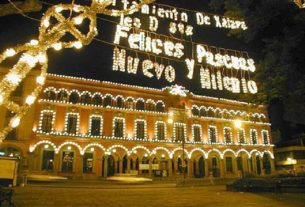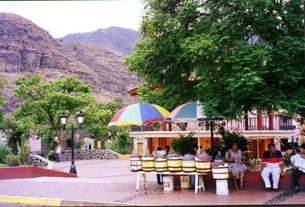Mexican Kitchen
When Francisco Hernandez de Córdoba, having set sail from Cuba in 1517, met a Maya in a canoe off the island of Cozumel, he was given gourds of water and balls of ground maize. This Mayan keyem, more commonly called by the Nahuatl name posolli, was the sustenance food carried by travelers in pre-Hispanic Mexico. Culinary anthropologist Sophie Coe writes that it was most often mixed with water to form a gruel, and was so venerated by the Chamula people that they placed bits of it in the mouths of the dead so that, just as in life, they could rest and be refreshed with posolli when they got tired. The Lacandon also had a high regard for posolli, offering it to the gods and saying, “If there are no women (to grind the corn), there is no posolli; if there is no posolli, there are no gods; if there are no gods, there is no sun.”
While modern Mexicans might not put it exactly that way, there is a great nationwide appreciation for pozole, the thick soup-stew descended from that ancient food. The chief similarity is that the basis of the dish is nixtamalized corn that is cooked until softened. (The word posolli came from the Nahuatl potzonti, meaning to boil or bubble.)
Nixtamalization, the process by which dried corn is soaked with cal (builders’ lime, calcium hydroxide) has been used by all Native American cultures that depended on corn as the basic carbohydrate. The soaking of the kernels with an alkaline substance such as lime, wood ash or natural soda releases the store of niacin in the corn and is necessary for softening it to make masa for tortillas and a whole range of other foods, including pozole. Each region of Mexico has its own version of pozole, but the soaking of the corn is essential to all of them.
The large-kernelled, white corn used for pozole, called cacahuazintle, can nowadays be found ready to cook, having gone through nixtamalization, in the refrigerated section of supermarkets all over Mexico and north of the border. However, carrying out the process of nixtamalization at home is uncomplicated, as well as being a hands-on lesson in food chemistry, perfect for kids who are budding chefs. (Authentic Mexican home cooking is somewhat labor intensive, which is why it is a family affair.)
Whether you start from scratch by processing dried corn, or buy the vacuum packed bags of nixtamal in the supermarket, or even substitute canned hominy, do make a large enough batch of pozole to feed friends or have leftovers. It is the perfect winter one-dish meal, with the “comfort food” qualities of the corn stew and the warming effect of the chile. Perfect for entertaining, pozole can be made ahead and reheated, and requires no side dishes except the condiments that are set out for people to add individually.
All of this probably explains why pozole is such a popular fiesta food, especially in western Mexico, where each state has several different local variations of the dish – red or white in Jalisco, green in Colima and Guerrero, white in Nayarit. In these areas, pork is the preferred meat for cooking in pozole. On the other side of the country, on the Veracruz coast, pozole is frequently made with the local seafood and fish.
Setting out a big, earthenware pot of steaming pozole, surrounded by plates of the traditional condiments of lime wedges, dried oregano, shredded lettuce or cabbage, chopped onion, sliced radishes, crumbled dried chiles and crisp fried tortillas, is an act that almost shouts “party” and would be ideal for January’s Super Bowl get-togethers, which are becoming increasingly popular here in Mexico. Soup bowls and spoons are the only tableware necessary for this wonderfully informal dish, which in Mexico is served in rounded clay bowls called pozoleros.
Although more commonly made with pork, pozole is also good with chicken. At many pozolerías (pozole restaurants) huge pots of both kinds simmer on the burners and customers can choose which they prefer. Pozolerías usually open in the evening and serve until late at night. The warmth and aroma of these places is enticing in the cool, crisp winter climate of Mexico’s high central plateau, although people in the warm coastal areas are some of the country’s biggest consumers of pozole. In Guerrero, on the Pacific coast, Thursday night is the traditional time to go out for pozole, and pozolerías are crowded with families enjoying this favorite regional dish.
The following pozole recipes are all worth a try, including the one for nixtamalization of corn. If using the refrigerated nixtamal kernels, rinse them very well before using. For cooks in a hurry, canned hominy can be substituted, but be aware that most canned hominy sold north of the border is treated with a different alkali and does not taste the same. Some brands of canned hominy sold in the US, including Juanita, Royal Crown and El Mexicano, are processed the traditional Mexican way, and would be more acceptable substitutes. If canned hominy is used, it should be added to the pot once the meat is tender.
These recipes each make about ten servings. For the pork version, Mexicans use the head and trotters as well as pork stew meat; however, since the head is not commonly appreciated in much of North America, the trotters and pork leg, or just pork leg alone, can be used. Have the butcher include some bone, which will add flavor.
- Nixtamal para Pozole: Pozole Corn
- Pozole Blanco: Basic White Pozole
- Pozole Rojo Jalisciense: Jalisco Style Red Pozole
- Pozole Verde con Pipian de Guerrero: Guerrero Style Green Pipian Pozole
- Pozole con Mariscos: Seafood Pozole


